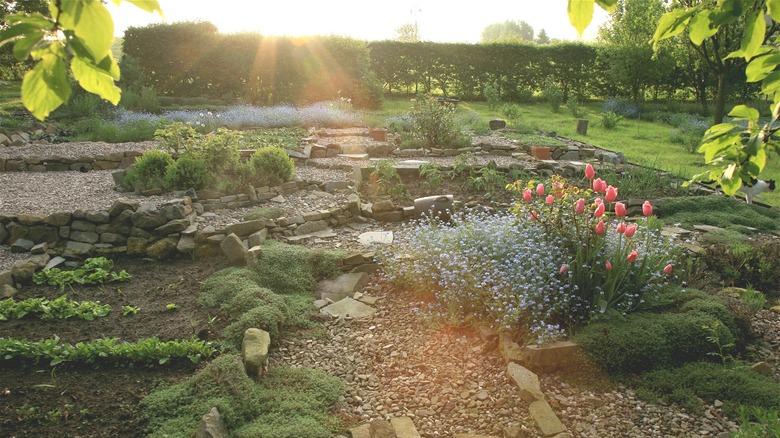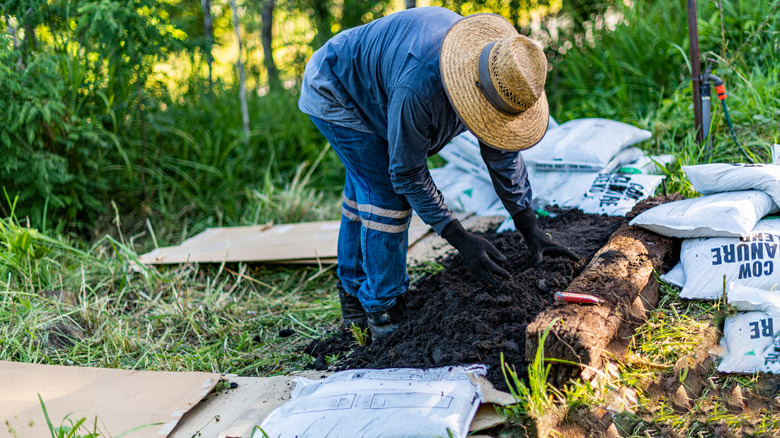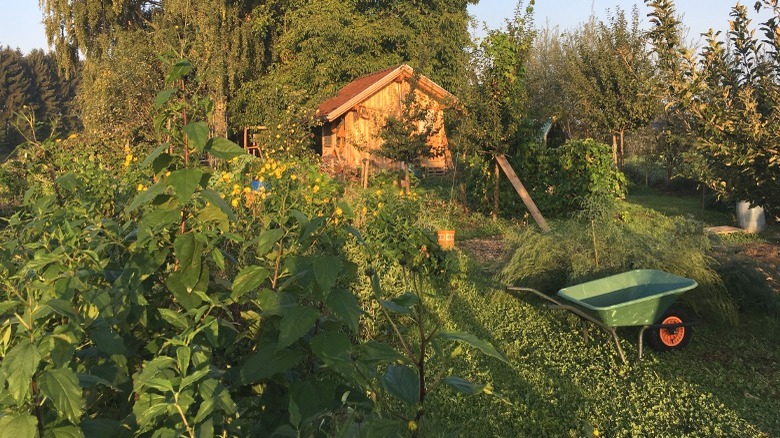Permaculture May Be The Key To A Thriving Garden
Although it's gained some serious traction in recent years, permaculture is hardly a new concept. In the 1970s, Australian researcher, author, and biologist Bill Mollison created the term, which is a combination of "permanent agriculture" and "permanent culture" (via Permaculture News). In other words, Permaculture is a form of landscaping and gardening that is carefully designed to support human needs while withstanding the test of time and leading us to a brighter future. Permaculture is more than just an eco-trendy gardening style; it's a commitment to releasing imperfections, embracing balance with nature, and taking care of people and resources. A permaculture approach leads to a thriving garden because it promotes slow, stable growth and works with the environment rather than against it.
These gardens are an extension of the landscape and a permanent part of the surrounding natural culture. Permaculture gardening employs twelve principles, all of which are aimed at reducing waste, respecting resources, and incorporating the ecosystem into your daily life. Learn more about the key principles of permaculture and how you can use them to establish a thriving and sustainable garden of any size.
Understanding permaculture theory
Permaculture follows a set of twelve principles: observe and interact; capture and store energy; obtain a yield; self-regulate and listen to feedback; use and protect renewable resources; minimize waste; learn and imitate natural patterns; integrate natural spaces; choose slow and steady options; use and value diversity; use edges and value the marginal, and be creative with responses to change (via Permaculture Principles). If that seems like a lot to remember, these twelve principles boil down to three central ethics: care for people, care for the planet, and take only your fair share.
In permaculture, gardeners opt for native and low-maintenance plants as much as possible to reduce their water footprint and attract local wildlife. They also employ a succession system, a no-till gardening method where one established plant fades, and another grows in as seasons change. Permaculture gardens should have a healthy mix of edible plants, herbs, and pollinator-friendly flowers, with plenty of room for naturally occurring vegetation, even some "weeds!" Permaculture is different from other native, organic gardening methods, however, because permaculturists look for every opportunity to benefit the environment as a whole. Recycling is a major factor, such as using greywater for gardens, composting waste for garden beds, and cardboard weed barriers. Gardeners also avoid buying more waste, such as plastic bags or planters, and find ways to reuse these materials if necessary. Natural pest control and sustainable designs help to grow healthier and more self-sufficient plants over time.
Plotting and starting a permaculture garden
Space is a resource in permaculture gardening, so it's important to organize your space efficiently and carefully. Many people find it helpful to separate their land into zones, radiating out based on care and maintenance needs. Zone 1, your home or porch, should be for plants requiring frequent attention, like sprouts, seedlings, herbs, and berries. Zone 2 is for plants needing occasional attention, like fruit shrubs, perennials, vegetables, and ponds or bogs. In zone 3, you'll keep plants that need rare attention, including fruit and nut trees and pollinator gardens. Zone 4 is untamed land that you can use to forage for native berries, herbs, mushrooms, or timber, while zone 5 is a wilderness that you'll leave completely untouched.
If this sounds overwhelming at first, don't be discouraged. It can take years to get a permaculture garden running on its feet. Think slow and steady changes, and start by choosing high-quality and sustainable plants, seeds, soil, and landscaping materials. Prioritize native and low-maintenance plants, use mulch and other materials to reduce your need to till, and recycle wherever you can. For example, turn old ladders into trellises, use old paint cans as flower pots, and weave plastic bags into baskets. Permaculture isn't about having a gorgeously curated and blossoming landscape; it's about creating spaces that benefit people and the planet. It's okay to let go of perfection and take baby steps to make your garden more sustainable.


